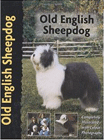
Old English Sheepdog
Old English Shepherds are playful, strong-willed, versatile dogs, which need a lot of grooming. They need a lot of commitment because they can be a handful if not properly trained, and if they don't get enough exercise. They are at higher risk of being euthanased for behavioural problems than Jack Russell Terriers. A large breed dog can create more havoc when things go wrong!
Perhaps one problem is that they look such cuddly dogs, and make people laugh when they clown. It's too easy to let them get away with things they shouldn't really do when they are pups, and by the time they get to be big, bouncy, powerful dogs, it's much more difficult to train them. They are also dogs that were used to help drovers take sheep and cattle to market, so if you don't tell them what to do, they will tend to try to herd you and anyone else they think needs pointing in the right direction. They need to be trained in house rules from the day they arrive in your home, and they do train well as pups. Old English Sheepdogs are intelligent, and want to be entertained by their owners, so they can find training enjoyable. They have learnt to play a number of roles and take part in different activities, including agility, herding and search and rescue, and they can perform well in obedience competitions. They need both mental stimulation and physical exercise, and dogs that are just let out to play in the garden in the evening, and are shut up all day while you are out at work can rearrange your house for you in ways you would rather they didn't, just out of boredom. They do enjoy games, such as 'hunt the titbit', which you can play with them at home if you are too tired to go for a long walk and your dog is bored, and you can play active games with them in your garden, but generally they benefit from a long walk every day.
Are they good with children? Well-trained Old English Sheepdogs can be excellent companions with children, though this breed does take some time to mature, and younger dogs are often a little too large and bouncy for smaller children. They way they behave with other dogs varies. They can be very good playmates with some of the larger, more robust and playful breeds, but they do need careful socialization as pups, since some individuals can be dog aggressive.
The biggest downside of the breed is perhaps the need for a lot of grooming, since Old English Sheepdogs have a distressing tendency to mat unless groomed very frequently. Mats are difficult to remove, once they form, and sometimes have to be shaved off. You will benefit from a session with a groomer, who can show you how to groom your dog, because it takes a lot of patience. Little and often is the secret, since if you let the mats develop, grooming becomes an ordeal for you and your dog. Some people trim the dogs' coats, which makes grooming a lot easier. Old English Sheepdogs have a double coat, and are well protected against the weather. They can stand the cold well, but have to be protected from the heat in summer, and should not be allowed to run around too much in the hot sun, or be left where they have no access to shade. They aren't especially bad shedders, so long as they are groomed regularly.
This breed can be very barky, though it is less of a problem if they get enough exercise. They have a deep bark, which can be useful to deter unwanted visitors. Some can be protective, while others can be very friendly when an unaccompanied visitor comes into the home, after having given a deep 'Woof', and this friendliness can apply to burglars!
Common health problems include hip dysplasia and eye trouble. You also need to be careful with their nutrition while they are growing pups, when they tend to eat a lot. Like all long-coated breeds, it is often difficult to tell whether they are too fat or too thin, so it's a good idea to feel for the ribs and backbone, and try to work out the ideal weight for the dog, then weigh the dog regularly, for example every week. Their food requirements will fluctuate while they are growing - young dogs often go through dormant phases when they don't eat much, then eat more, but their needs will become more stable when they become adults, with more food needed when they are active, and it's cold, and less needed when it's hot and when they are not so active.
This guide to the breed covers the breed history, temperament, choosing a puppy, training, feeding, grooming, and showing old English sheepdogs. There is also useful advice on preventative health care, and puppy-proofing your home important with such a large, bouncy breed. Lastly, there is help with caring for oldsters. The book is clearly written, with enough information to interest experienced owners as well as novices. The book is also well-illustrated, with more than 135 colour photos.



